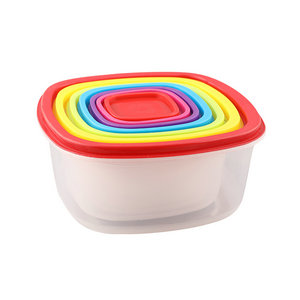

Types and hygienic standards of food packaging material […]
Types and hygienic standards of food packaging materials
Types of food packaging materials The currently allowed food containers, packaging materials, and tools and equipment used to manufacture food include (1) plastic products—thermoplastics, thermosetting plastics, and other serialized products, and plastic additives; (2) rubber products—one Serialized products such as natural rubber, synthetic rubber, and rubber additives; the additives used for the first three organic substances must meet the requirements of GB~85-1994 "Sanitary Standards for the Use of Additives for Food Containers and Packaging Materials"; (3) Food Containers Inner wall coatings-normal temperature film-forming coatings, high-temperature curing film-forming coatings and additives; (4) ceramics, enamel tableware; (5) aluminum products, stainless steel tableware containers, iron tableware containers, glass tableware Containers; (6) Series products such as paper for food packaging; (7) Series products such as composite packaging bags-composite film, composite film bags. 1.2 The main hygienic indicators of food packaging materials The hygienic indicators of food packaging materials mainly include: evaporation residue (acetic acid, ethanol, n-hexane), potassium permanganate consumption, heavy metals, residual toxins, etc. In the sanitary standards of food containers and packaging materials, all kinds of liquids are used to soak, and then the migration amount of the relevant components of these liquids is measured.More about:plastic food container

The choice of solvent is determined by the type of food container and packaging material contacting the food. Under different physical conditions, chemical substances are generally used, such as distilled water (representing neutral food), 4% acetic acid (representing acidic food), 8 % ~60% Ethanol (representing food containing alcohol), n-hexane (representing oily food); the consumption of potassium permanganate in the solvent of distilled water after soaking or called oxygen consumption (representing the total organic matter and The amount of insoluble matter); decolorization test; other based on arsenic, fluorine, heavy metals (lead, cadmium, antimony, germanium, cobalt, chromium, zinc), organic monomer residues, lysates (vinyl chloride, benzene Ethylene, phenols, nitrile rubber, formaldehyde), additives, aging substances and other harmful elements. Evaporation residue represents the total amount of soluble and insoluble substances that migrate into the food. It reflects the possibility of breaking out residues, heavy metals, fluorescent substances, and residual toxins when the food packaging bag comes into contact with liquid during use.
If such food packaging is used to hold food, the food will be contaminated to varying degrees. After people eat it, toxins will enter the human body and be deposited in internal organs for a long time, causing chronic poisoning. In particular, excessive heavy metals in the human body will weaken the human immune function. Damage to the nerves, hematopoietic and reproductive systems, especially to the physical and intellectual development of children and adolescents in the growth stage, hinders, slows down and even irreversible side effects. 1.3 Hygienic standards of food packaging materials In terms of hygienic standards, there are two aspects: raw materials and products. In terms of hygiene standards for raw materials, there are GB9691 "Hygienic Standards for Polyethylene Resin for Food", GB96~ (Hygienic Standards for Polystyrene Resin for Food" and GB9693 {Hygienic Standard for Polypropylene Resin for Food". In these three Among the resin standards, polyethylene and polypropylene are used the most, and polystyrene is the least, and will be less and less. In addition, in addition to these three resin standards, there are polyester (PET), nylon (PA) and other standards abroad. The hygienic standards of resins. In the hygienic standards of these raw materials, there are provisions for heavy metal content, evaporation residue, potassium permanganate consumption, decolorization indicators, etc., and foreign indicators include aldehyde content, cadmium, arsenic, mercury and other heavy metals Content, phenol and amine content, etc. The hygienic standards for molded products include GB% 87 {Hygienic Standards for Polyethylene Molded Products for Food Packaging", GB9688 {Hygienic Standards for Polypropylene Molded Products for Food Packaging", GB9689 "Food Packaging Hygienic Standard for Polystyrene Molded Products" and G~683 {Hygienic Standard for Composite Food Packaging Bags". In the first three sanitary standard items for molded products, there are specific indicators for evaporation residue, potassium permanganate consumption, and heavy metal content. In the fourth "Composite Food Packaging Bag Hygiene Standard", an indicator that the content of diaminotoluene should not be greater than 0.004 ml has been added. This is because in food packaging materials, the trace amounts of harmful substances in the adhesive will also It affects the sanitary performance of the entire system, and the diaminotoluene is a carcinogen, which must be strictly controlled. There must be corresponding sanitary standards for molded products. The purpose is to prevent misuse and abuse of additives, and to better protect the direct Packaging and food contact materials have a high degree of hygienic safety performance.
In addition to the above-mentioned hygienic standard items and indicators, China’s composite packaging material standards include a requirement that residual solvents must not exceed 10 m kg, such as GBIO0(~ and GB10005 Recently, the content that the residual amount of toluene should not be greater than 3 m kg has been added. This is due to the stricter requirements on the odor and potential toxicity of packaging materials in recent years. Therefore, in addition to limiting its residual amount, Following this, new products such as water-based inks and adhesives, alcohol-soluble inks and adhesives, and solvent-free adhesives have been developed. The purpose is to ensure that composite materials have higher purity, hygiene and safety performance. In order to control food containers and packaging For the hygiene and safety of materials, our country has formulated GB9685 {Hygienic Standards for the Use of Auxiliaries for Food Containers and Packaging Materials". In the hygiene standards of this auxiliary, 17 categories and 58 specific substances are specified, including additives, solvents, and adhesives. The name and maximum usage amount of FDA are similar to FDA2l CFR&175.

Copyright © Taizhou Qiming Plastic Co. LTD Rights Reserved. Support by: HWAQ China Plastic Funnels Suppliers